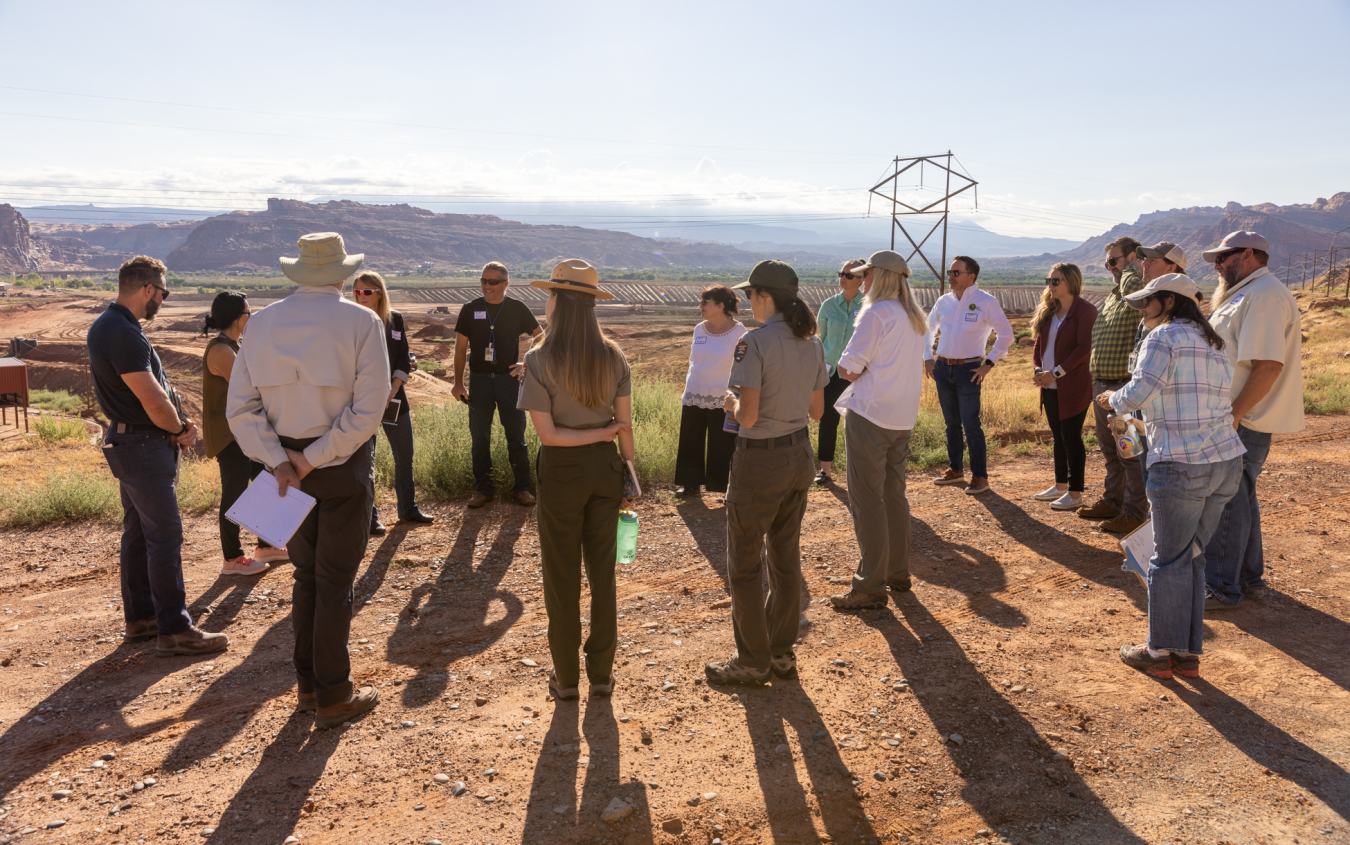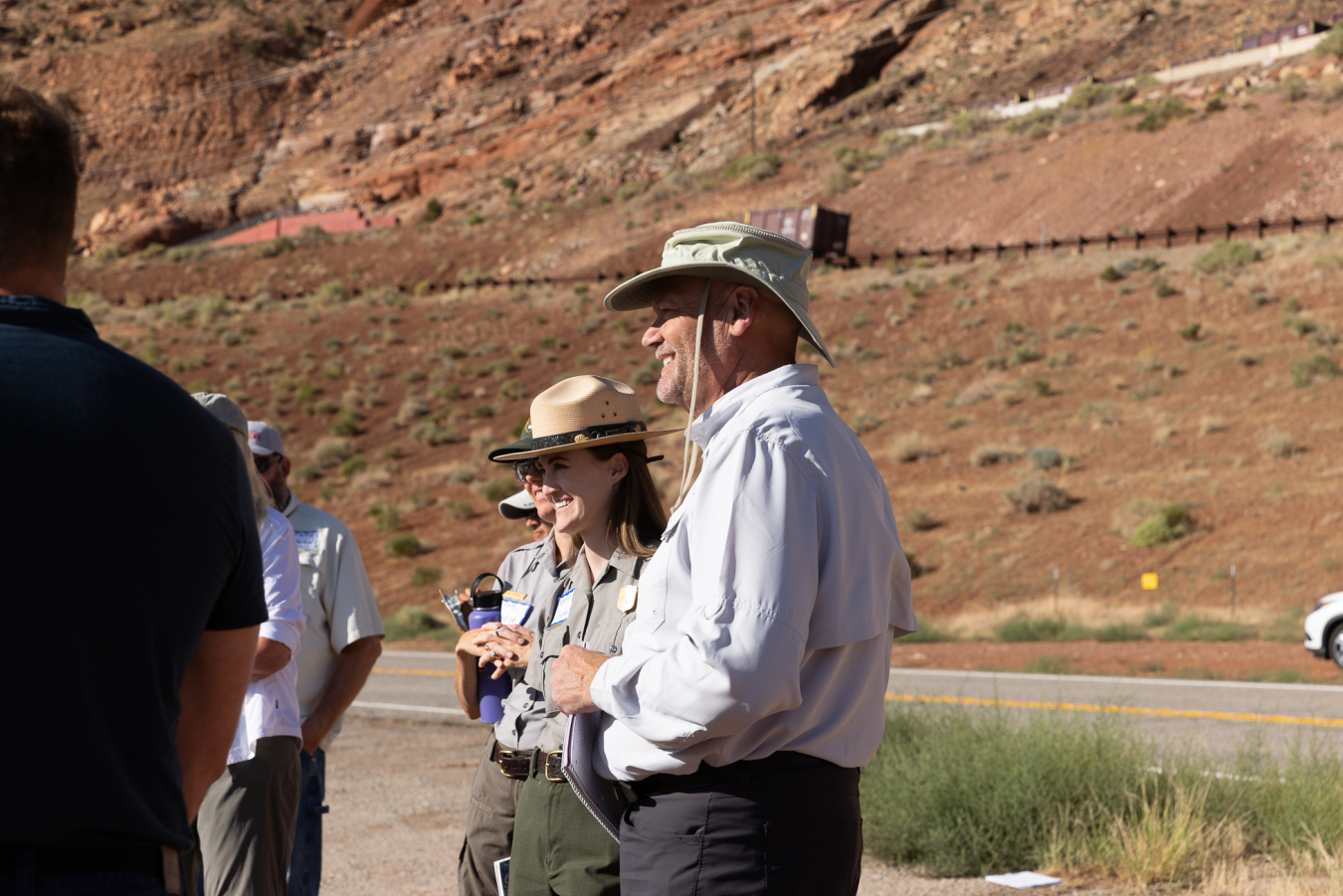How DOE’s EM and LM teams engage local partners together.
November 4, 2022Just after sunrise on a September morning, a caravan of U.S. Department of Energy (DOE) personnel was driving through the Utah desert when the empty highway gave way to an area known as “God’s country.”

Representatives of DOE meet with other federal and municipal officials at a tour of a former uranium-ore processing facility near Moab, Utah, in September.
“Everywhere you look, rock formations and just incredible wide-open space. The sun was hitting the rocks behind us and really lighting them up,” said David Von Behren, Public Affairs supervisor for DOE’s Office of Legacy Management (LM). The red glow of Arches National Park in Moab was an unmistakable you-have-arrived sign.
Following behind Von Behren were fellow DOE employees and contractors heading to meet their counterparts from the Office of Environmental Management (EM).
Rarely does an arresting view of unbridled beauty render teams of environmental stewards speechless, but Von Behren said all of them were awestruck.
“It was just so striking when you drive in there and it sort of changes your mindset. You feel more relaxed when you get next to nature that's that beautiful.”

LM Public Affairs Supervisor David Von Behren and Arches National Park ranger Kaitlyn Thomas meet with DOE employees, contractors, and other representatives of federal and local agencies at a visit to the Atlas site in Moab, Utah, in September.
“Moab embodies everything Americans think of when we picture ‘the West,’ LM Site Manager Ken Kreie said. “Those images — the red spires and the sagebrush — it’s just a concentration of that archetypal beauty. You know they shoot movies there all the time.”
Dozens of iconic movies, including “Indiana Jones and the Temple of Doom,” were shot in Moab. None of that’s lost on those present, as the EM team begins their briefing to the National Park Service and Moab area leadership. The purpose of the meeting was for EM to provide an overview of the former Atlas site and discuss its potential future uses.
“We were their guests for the visit to the Atlas site overlook. But it's important that we start the partnership early not only with EM, but also with local partners, particularly when there's a site like this that has high traffic,” said Von Behren, noting the popularity of the storied park.
Atlas is a former uranium-ore processing facility, known as a mill site, in Moab. The purpose of the project is to relocate mill tailings and other contaminated materials from the site to an engineered disposal cell built near Crescent Junction, Utah. The scope also includes active remediation of groundwater.
“This area of Moab is unique, encompassing world-class parks and stunning natural wonders,” said Matt Udovitsch, acting federal project director of EM’s Moab site. “The team at EM understands that our work, and the cleanup of the Moab site, is pivotal.”
Based in Grand Junction, Colorado, EM is currently managing the cleanup of the Atlas site. Once all remediation is complete in three to four years, EM will turn the site over to LM for long-term stewardship. Kreie said, in the past, two years was typically the transition window, but building connections with the community stakeholders takes time.
“We realized that that's just not sufficient time to really establish relationships,” Kreie said. “They're making decisions now that if we are involved, they may consult with us as they move forward. So, we end up with a site that's easier or more manageable in the future.”
“The thing that stood out to me was that everyone at that meeting had reverence for the beauty and the importance of Arches National Park and being part of its stewardship,” Von Behren said.
“We value the collaboration with LM, ensuring that this treasured land is taken care of well beyond the site’s cleanup,” Udovitsch said. “Sharing the site’s beauty on this tour was one of many collaboration efforts to restore and maintain the local landscape’s natural beauty for generations to come.”

